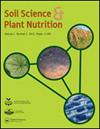不同氮源和浓度处理水稻根系伸长数量性状位点定位
IF 1.8
4区 农林科学
Q3 ENVIRONMENTAL SCIENCES
引用次数: 0
摘要
根是植物吸收水分和养分的重要器官。根系长度响应受植物氮(N)来源,如铵离子(NH4 +)和硝离子(NO3−)及其浓度的影响。为了确定具有改良水稻根系潜力的遗传资源,在NH4 +或NO3−的低(5 μM)或高(500 μM) N浓度的水培培养基中,对334个核心渗入系(ILs)的根系发育性状进行了评价。il被分为三组。在所有条件下,聚类1的最大根长(MRL)均值均显著高于其他2个聚类。根数(RN)在集群IIa和IIb之间存在显著差异,集群IIa的平均RN更高。聚类平均总根长度的大小顺序为聚类I > IIa > IIb。因此,集群I中的il被认为是在所有氮条件下改善根系发育性状的遗传资源。在这些il中,YTH187(由YP5作为供体衍生而来)在所有条件下都具有较长的MRL。利用IR 64与YTH187杂交的重组自交系进行定量性状位点(QTL)分析,发现在所有N条件下均检测到qRL5.3-YP5和qRL6.5-YP5。相比之下,qRL4.1-YP5仅在低KNO3浓度下检测到,而qRL8.1-YP5在高浓度NH4Cl和KNO3下检测到。这些qtl上的YP5等位基因增加了MRL。水培水稻根系长度的qtl此前未在qRL8.1-YP5附近发现;因此,这可能是一个控制水稻根系长度的新QTL。此外,qRL8.1-YP5和qRL4.1-YP5可能是确定KNO3条件下水稻根系伸长机制的有用qtl,因为这些qtl尚未在这些条件下检测到。在未来的研究中,qRL8.1-YP5的进一步精细定位和表征可以揭示高KNO3浓度条件下根系伸长的机制。本文章由计算机程序翻译,如有差异,请以英文原文为准。
Mapping of quantitative trait loci for root elongation in rice (Oryza sativa L.) treated with various nitrogen sources and concentrations
ABSTRACT Roots are important plant organs that absorb water and nutrients. Root length responses are influenced by the plants’ sources of nitrogen (N), such as ammonium (NH4 +) and nitrate (NO3 −) ions and their concentrations. Here, to determine the genetic resources with the potential to improve the root system of rice (Oryza sativa L.), the root development traits of a core set of 334 introgression lines (ILs) were assessed in plants grown in hydroponic culture medium containing low (5 μM) or high (500 μM) concentrations of N in the form of NH4 + or NO3 −. ILs were classified into three clusters. The mean value of maximum root length (MRL) in cluster I was significantly higher than that in the other two clusters under all conditions. Root number (RN) differed significantly between clusters IIa and IIb, with the mean RN being higher in cluster IIa. In addition, the order of the mean total root length of the clusters was cluster I > IIa > IIb. Therefore, ILs in cluster I are considered genetic resources for improving root development traits under all tested N conditions. Among the ILs, YTH187 – which is derived from YP5 as a donor – had a longer MRL under all conditions. Quantitative trait loci (QTL) analyses, performed using recombinant inbred lines derived from a cross between IR 64 and YTH187, revealed that qRL5.3-YP5 and qRL6.5-YP5 were detected under all N conditions. In contrast, qRL4.1-YP5 was detected only under low KNO3 concentrations, whereas qRL8.1-YP5 was detected under high concentrations of NH4Cl and KNO3. YP5 alleles at these QTLs increased MRL. QTLs for root length in rice grown in hydroponic culture have not previously been detected in the vicinity of qRL8.1-YP5; thus, this may be a novel QTL that controls root length in rice. Moreover, qRL8.1-YP5 and qRL4.1-YP5 could be useful QTLs to determine the mechanism of root elongation under KNO3 conditions because such QTLs have not yet been detected under these conditions in rice. In future studies, further fine-mapping and characterization of qRL8.1-YP5 could reveal the mechanism of root elongation under high KNO3 concentration conditions.
求助全文
通过发布文献求助,成功后即可免费获取论文全文。
去求助
来源期刊

Soil Science and Plant Nutrition
农林科学-农艺学
CiteScore
4.80
自引率
15.00%
发文量
56
审稿时长
18-36 weeks
期刊介绍:
Soil Science and Plant Nutrition is the official English journal of the Japanese Society of Soil Science and Plant Nutrition (JSSSPN), and publishes original research and reviews in soil physics, chemistry and mineralogy; soil biology; plant nutrition; soil genesis, classification and survey; soil fertility; fertilizers and soil amendments; environment; socio cultural soil science. The Journal publishes full length papers, short papers, and reviews.
 求助内容:
求助内容: 应助结果提醒方式:
应助结果提醒方式:


